Lessons we have learned
 Is
there a ‘best way’ to teach the Weaves? Lesley Harpley has tried them all. Her conclusions are
that all dogs are different. There is no 'universal best way.' Here she shares some personal
case studies spanning the last decade and the lessons she has learned! Is
there a ‘best way’ to teach the Weaves? Lesley Harpley has tried them all. Her conclusions are
that all dogs are different. There is no 'universal best way.' Here she shares some personal
case studies spanning the last decade and the lessons she has learned!
1992 Barnaby – Getting the basics right
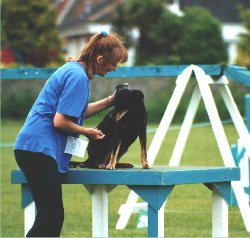 Now
14, Barnie was a rather timid rescued cross breed, from Chiltern Dog Rescue Society (CDRS),
with some definite ‘Lurcher’ tendencies (all or nothing!) In those days, most of the training
was still on the left, and we were generally encouraged to train on all the weaves in upright
position. Now
14, Barnie was a rather timid rescued cross breed, from Chiltern Dog Rescue Society (CDRS),
with some definite ‘Lurcher’ tendencies (all or nothing!) In those days, most of the training
was still on the left, and we were generally encouraged to train on all the weaves in upright
position.
Lesson One:
Train on both sides from the start, and get the entry right!
I remember the look on my instructors face, when I delightedly showed her my ‘homework’ and
Barnaby promptly went in on the wrong side!
Barnie was quite tough to train,
because he was in all respects a rather ‘proper’ dog, and it was quite difficult to get him to
play and go on after a toy. I never really managed to ‘wean’ him off my body and hand movements
when weaving, and he never really achieved a very fast technique. He regularly achieved top ten
places in Starters in his ‘middle’ years but sadly never a trophy. Barnie seemed to do better
in competition if we hadn’t done much training.
Lesson Two:
Get to know your dog and what switches him or her on... or off.
1996 Tommy – Speeding up the slower weaver
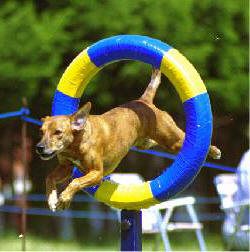 In
1994 I went to CDRS determined to ‘get a collie’ and came out with a five month old Whippet/Staffie
cross with a bit of terrier thrown in for good measure. In
1994 I went to CDRS determined to ‘get a collie’ and came out with a five month old Whippet/Staffie
cross with a bit of terrier thrown in for good measure.
By the mid 1990’s V-weaves and the
Channel method were being tried. We bought some yellow ‘bendy’ poles - like the kind used for
electric fences - and started on a cross between channel and V-weaves, angling the poles out as
the base came together.
It went fine and little Tommy flew
through them with the poles whipping about on both sides! Then, when he was old enough, we
migrated to upright poles and hit two obstacles:-
-
Tommy didn’t like having a metal base
under his feet (Back to square one!)
-
He couldn’t weave unless he could see
a gap through the middle! Bugger.
With weeks to go till his first show, I
reverted to the ‘steering’ method used for Barnaby. We got there, but still he was relying on
me too much and his weaves were still quite slow.
Some lessons with Kathrin Tasker at
that stage really helped, using the hinged V-weaves on a metal base and sending him on to a
food bowl with treats. Although I tried to be really encouraging, it seemed that Tommy
sometimes found it oppressive so we played tuggy games where I had to let him ‘win’ to build
his confidence.
Kathryn also occasionally encouraged
all the handlers to cheer and celebrate when each dog completed the weaves to make it exciting.
Tommy sustained reasonably fast weaves for several years, winning out of Starters in January
1999. He did tend to rely on me sustaining some sort of encouraging noise throughout though,
which was not always physically possible!
Lesson Three: Do get some weave poles at
home. (Don’t weave upright until the youngster is at least 12 months old).
Lesson Four:
Check out how your dog is reacting to your ‘encouragement’ does he or she feel
pressurised? If so it could have the opposite effect.
1999 Star - V-weaves & Channel methods
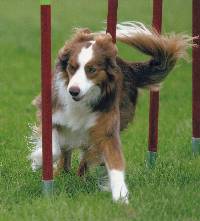 At
last, my dream girl, my puppy, my border collie! Oh, the months of anticipation. This time, I
was determined to let Star work ‘for herself’ and not to ‘over handle’ the weaves. At
last, my dream girl, my puppy, my border collie! Oh, the months of anticipation. This time, I
was determined to let Star work ‘for herself’ and not to ‘over handle’ the weaves.
By now, I had my own hinged weaves on a
metal base and the bendy poles had been relegated to supporting the ‘fence’ around our caravan!
Again, we started with a combination of channel and V-weaves, around ten months old and very,
very gradually brought them in line.
Lesson
Five: With V-weaves, some dogs like to jump them if they
are not up enough (which means waiting for pups to grow up).
Star was just starting to weave like a
dream, when disaster struck and she broke her neck running into a horse fence in the dark!
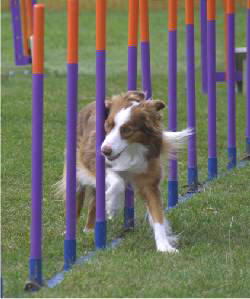 After
four very stressful months with Star restricted in a cage, we resumed training, and
miraculously, according to the orthopaedic vet, Star still loved her agility and was even still
able to weave. Of course, I was very nervous and so passed this on to Star. After
four very stressful months with Star restricted in a cage, we resumed training, and
miraculously, according to the orthopaedic vet, Star still loved her agility and was even still
able to weave. Of course, I was very nervous and so passed this on to Star.
Our first year was rather hit and miss,
but Star went on to win about a dozen trophies and numerous top ten places in Novice. Star has
never settled into a particular style of weaving, although she is definitely better if I
hang back and let her get the entry ahead of me and if I stay in line with her shoulders.
Sometimes she weaves ‘single’ footed and sometimes misses her step and does a few with both
feet. Unfortunately, she now also has Addison’s disease (a hormonal imbalance related to the
kidneys) and so is rather ‘up and down’ these days. But she is still my golden girl and
everything she does is magic for me.
Lesson Five: Work out where your dog
likes you to be - ahead, behind, close or further away.
2001 Casey – Using wires and extra poles to stop an ‘excitable’ dog skipping
weaves
Casey is Colin’s dog. In 2001 we
rescued her from CDRS, aged twelve months old. She is a pretty special example.
| She had not been socialised at all,
nor housetrained, and was something of a psychological wreck. Casey was very
difficult. When we got her she showed signs of nervous aggression to people and dogs, but
could also give appearances of being quite dominant.
In short, I was determined that Casey would weave
for herself so schooled Colin (who was new to agility) not to over work the weaves. Casey
tended to leap over V weaves, so we had to start with them quite close together, maybe 6
to 12 inches apart at the top. Casey loved it. We migrated to upright poles and Casey
kept missing poles.
First it was the entry, then the end and then
finally she settled on missing poles in the middle. Casey’s history made it virtually
impossible to guide her by hand, as she became too distressed. So, we tried the wires. |
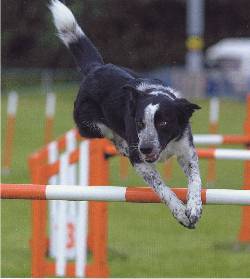
For some insight into the story of how we
re-habilitated Casey, click on the link here.
Casey’s Story |
To start with Casey jumped them. We
moved them up a bit. Then she went under them. So we added a second wire. After a few weeks,
Casey was flying through the weaves with complete success. Then it came to transferring the
skill to the environment of a show. For the first few shows it worked, with Casey winning out
of Elementary and Starters in her first three shows. Then she started getting ‘cocky’ and
no-go! Casey reverted to skipping weaves, now typically coming out at the tenth pole!
So, how did we
solve it?
This time with advice from Sue White, we put a second pole beside the tenth pole (one
the outside, thus making it subtly more difficult for her to bypass the pole). We had an
opportunity to do that in the show environment in a ‘practise ring’ at Supadogs. We only had a
minute, so I ran in and ‘planted’ one of the long jump uprights by the tenth weave. It worked
and now Casey generally weaves fast and accurately.
Lesson 6:
If a dog is struggling, find ways to make it easier
for them to get it right.
Lesson 7: If
there is a practise ring, use it to transfer a skill into a show environment.
2003 Mace – Mixing methods, training the entry separately, back chaining
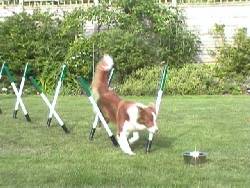 Finally,
my new pup Mace recently started weaving upright at 15 months. Again, we used a combination of
both the channel method (at Aylesbury CTS) and the V method at home from around ten months,
keeping it lots of fun and using toys and treats. But this time, I taught him the entry
separately. Finally,
my new pup Mace recently started weaving upright at 15 months. Again, we used a combination of
both the channel method (at Aylesbury CTS) and the V method at home from around ten months,
keeping it lots of fun and using toys and treats. But this time, I taught him the entry
separately.
I did this after talking to several
good handlers who ‘back chain’ weaves, starting with very few (three or four) and doing
that confidently before building up to twelve. So, I started with three weaves, at a very
slight angle, in the living room before his breakfast! We then moved on to four upright weaves,
a slight angle and so on. It does seem to have helped. (I still trained a whole set of twelve
weaves using the channel and V method though.)
A key advantage is that Mace has got
some experience of different types of weave pole, wooden and plastic and does seem to look for
the entrance. He still sometimes misses a weave, but not so much as Casey did so I don’t feel I
need to resort to the wires. I have forced myself to hold back from over handling the weaves -
believe me it has been hard at times - and to let him do it for himself. We had a patch of very
slow weaving after coming upright, but he does seem to be speeding up a lot now he is getting
more confident. Mace seems to be quite sensitive, so I do force myself to stop if he is
successful once and make it lots of fun, throwing a toy at the end and playing tuggy. Time will
tell, but fingers crossed.
Lesson 8: try to let the dog work for
himself or herself.
Lesson 9:
Stop if it works!
Lesson 10: Break the training into
separate stages, such as training the entry separately on a few weaves.
To summarise
We have had quite different experiences training our own five very different dogs. Each dog is
different and there is no one best way to train. Do what
works for your dog. If I have two words of advice, it would be:
-
Make it easy for the dog to succeed
the first time and stop right there on a positive.
-
Buy the guide How to Train Your
Dog to Weave for Chilterns Dog Rescue Society (please).
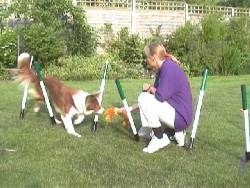 About
the author... About
the author...
Lesley Harpley is one of the team of Instructors at Aylesbury CTS, where the club
has a great variety of rescued and mixed breed dogs as well as some rather lovely pedigree
dogs!

|  Finally,
my new pup Mace recently started weaving upright at 15 months. Again, we used a combination of
both the channel method (at Aylesbury CTS) and the V method at home from around ten months,
keeping it lots of fun and using toys and treats. But this time, I taught him the entry
separately.
Finally,
my new pup Mace recently started weaving upright at 15 months. Again, we used a combination of
both the channel method (at Aylesbury CTS) and the V method at home from around ten months,
keeping it lots of fun and using toys and treats. But this time, I taught him the entry
separately.  About
the author...
About
the author...